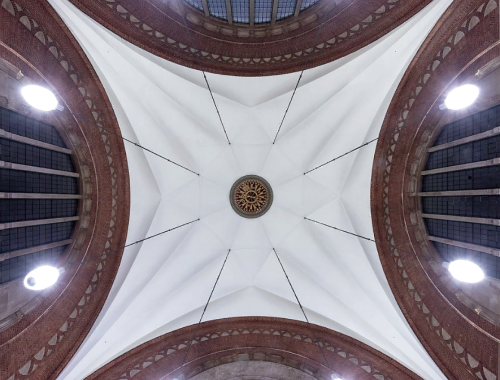Genocide in Gaza (IV) – The irish testament (ICJ)
International Court of Justice has summoned Israel, put on trial for crime of genocide, in the light of the application from Southafrica. Not only is Israel to examination – ICJ, UN and mankind itself is to examination. Blinne Ní Ghrálaigh´s speech.
Genocide in Gaza ( 7 parts ) :
1 : Genocide in Gaza – ” year 75 “
https:/∆/www.nedersteetage.com/genocide-in-gaza/
2 : Genocide in Gaza – requiem
https:/∆/www.nedersteetage.com/genocide-in-gaza-2/
3 : Genocide in Gaza – a voice from Jerusalem 2024.12.23
https:/∆/www.nedersteetage.com/genocide-in-gaza-iii/
4 : Genocide in Gaza – the irish testament ( Blinne Ní Ghrálaigh, ICJ 2024 )
https:/∆/www.nedersteetage.com/genocide-in-gaza-iv/
5 : Genocide in Gaza – the judgment ( ICJ )
https:/∆/www.nedersteetage.com/genocide-in-gaza-v/
6 : Genocide in Gaza – ” exodus II “
https:/∆/www.nedersteetage.com/genocide-in-gaza-vi-hunger/
7 : Genocide in Gaza – Quo Vadis ?
https:/∆/www.nedersteetage.com/genocide-in-gaza-vii-the-curse/
( remove ∆ and you have the full link )
*
Israel has been waging war against the Palestinians for many years, with ethnic cleansing and war crimes, bombings of Gaza and the West Bank, etc. The war can be traced back to the early 1900’s, when the Zionists began their colonization and conquest of Palestine. All attempts to call the Zionists and the new state of Israel to sanity and unity have so far been in vain.
The question of Zionism is as central as the question of apartheid in South Africa was. Zionism is a wrong response to anti-Semitism and manipulates the history, memories and identities of the Jews. Zionism is turning the Jews – Europe’s former pariahs condemned not to assimilation – into European colonists in the Middle East.
This nationalist ideology is not only criminal to the Palestinians, but offers no solution for the Jews, whom it deliberately endangers and whom it will mislead into traitors or accomplices.
*
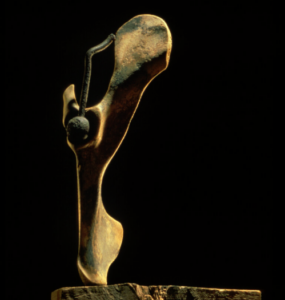
” Map of the Middle East – cut to the bone ” Designed by Sykes-Picot
Generel impression from the International Court of Justice:
Southafrica´s application to ICJ focuses on the actions carried out by Israel in Gaza, especially after 7th october 2023 – in the context actions against Palestine and the palestinian people during the last 76 years, or more. Israel responds rhetorically, pointing in all other directions, than in direction of Israel itself. Israel simply ignores the actions mentioned in the southafrican application. Rhetoric doesn´t change the reality on the ground.
Besides Israel and SouthAfrica, The International Court of Justice is to examination – UN is to examination – mankind itself is to examination. Time will show who will pass or fail.
From the opening :
.
.
This Application concerns acts threatened, adopted, condoned, taken and being taken by the Government and military of the State of Israel against the Palestinian people, a distinct national, racial and ethnical group, in the wake of the attacks in Israel on 7 October 2023 :
South Africa presents :
https:/∆/www.youtube.com/watch?v=4f_yoal4gx8
.
.
Israel´s response :
https:/∆/www.youtube.com/watch?v=939hSvcH0qM
*
“ We did what we could. Remember us ”
Blinne Ní Ghrálaigh, ICJ 2024
Blinne Ní Ghrálaigh :
( ICJ, january 2024 extract : conclusion )
&
ICJ – irish Blinne Ghralaigh statement Urgency and irreparable harm
( or read full manuscript below )
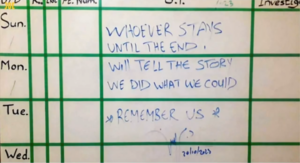
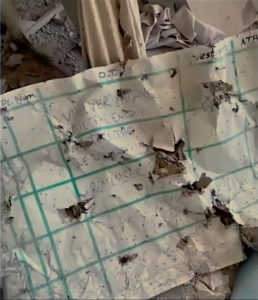
” Madam President, Members of the Court, in conclusion I share with you two photographs. The first is of a white board at a hospital — in Northern Gaza — one of the many Palestinian hospitals targeted, besieged, bombed by Israel over the course of the past three brutal months. The white board is wiped clean of no longer possible surgical cases, leaving only a hand-written message by a Médecins Sans Frontières doctor which reads:
“We did what we could. Remember us”.
The second is of the same whiteboard, after an Israeli strike on the hospital on 21 November 2023 that killed the author of the message, Dr Mahmoud Abu Nujaila, along with two of his colleagues.
Just over a month later, in a powerful Christmas Day sermon, delivered from a church in Bethlehem — on the same day Israel had killed 250 Palestinians, including at least 86 people, many from the same family, massacred in a single strike on Maghazi Refugee Camp — Palestinian Pastor Munther Isaac addressed his congregation and the world. He said:
“Gaza as we know it no longer exists. This is an annihilation. This is a genocide. We will rise. We will stand up again from the midst of destruction, as we have always done as Palestinians, although this is by far maybe the biggest blow we have received.” But he said: “No apologies will be accepted after the genocide . . . What has been done has been done. I want you to look at the mirror and ask, ‘where was I when Gaza was going through a genocide’.”
South Africa is here before this Court, in the Peace Palace. It has done what it could. It is doing what it can, by initiating these proceedings, by seeking interim measures against itself as well as against Israel.
South Africa now respectfully and humbly calls on this honourable Court to do what is in its power to do, to indicate the provisional measures that are so urgently required to prevent further irreparable harm to the Palestinian people in Gaza, whose hopes — including for their very survival — are now vested in the Court. “
Palæstinas regression – Israels ekspansion
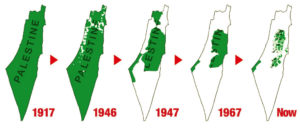
1917 : Situationen i den osmanniske periode ( ca 400 år )
1946 : udenlandsk jordopkøb, ekspropriering af palæstinensiske bønder frem til statsdannelsen af Israel, jøder udgør under 10%,
1947 : den nye deling ml Palæstina / Israel, jøder udgør 30%, palæstinensere 70% – landareal : 55% til jøderne, 45% til palæstinenserne
1967 : grænserne efter Israels invasion/besættelse af Palæstinsisk territorium, jøderne har ca 80% af landareal, palæstinenserne ca 20%
2023 : Palæstina reduceret til koncentrationslejre under total israelsk kontrol
– læg dertil Israels angreb på nabostater og okkupation af fremmed territorium, på Sinai, i Sydlibanon og Golanhøjderne i Syrien …. and still counting …
.
.
Genocide in Gaza ( 6 parts ) :
1 : Genocide in Gaza – ” year 75 “
https:/∆/www.nedersteetage.com/genocide-in-gaza/
2 : Genocide in Gaza – requiem
https:/∆/www.nedersteetage.com/genocide-in-gaza-2/
3 : Genocide in Gaza – a voice from Jerusalem 2024.12.23
https:/∆/www.nedersteetage.com/genocide-in-gaza-iii/
4 : Genocide in Gaza – the irish testament ( Blinne Ní Ghrálaigh, ICJ 2024 )
https:/∆/www.nedersteetage.com/genocide-in-gaza-iv/
5 : Genocide in Gaza – the judgment ( ICJ )
https:/∆/www.nedersteetage.com/genocide-in-gaza-v/
6 : Genocide in Gaza – ” exodus II “
https:/∆/www.nedersteetage.com/genocide-in-gaza-vi-hunger/
( remove ∆ and you have the full link )
.
.
En lignelse :
..
..
Læs den bibelske fortælling om mønten, ” med kejseren på den ene side, og gud på den anden “ ~ ” giv gud hvad guds er – giv kejseren hvad kejserens er ” , lyder det besnærende svar.
.
~ hvor blev holdningen til “den tredie part” af ?
.
( “den 3. part” = den der støber mønten ~ banken ~ mellemhandleren ~ Loke-figuren i den nordiske fortælling ~ satan i den kristne fortælling )
.
Se på hvem der stiller spørgsmålet ( i fortællingen ) !
.
Se på hvem der opstiller valgene – idag på en privat eller offentlig institution, eller i den danske regering og i de større magtkonglomerater over denne, idag i Mellemøsten, og for ca 2000 år siden i de bibelske fortællinger.
.F
Flere reflektioner i forlængelse heraf :
https:/∆/www.nedersteetage.com/penge/
( fjern ∆ så har du det fulde link )
.
.
.
.
.
Comments :
.
https:/∆/www.youtube.com/watch?v=h6Rc5DKHlow
.
.
https:/∆/steigan.no/2024/01/israel-mislyktes-totalt-med-a-tilbakevise-anklager-om-folkemord/
( remove ∆ and you got the full link )
SA-ICJ-team arriving in South Africa
*
Norman Finkelstein :
*
Comment 13.1.2024 :
” The most important in the ICJ has already happened. The substance is very clear : South Africa is the most qualified when it comes to knowledge and expertice about apartheid, indeed costly payed by the suffering of southafrican indiginous people. This leads to the next : Israel are commiting genocide, and has done since its beginning 76 years ago, but hitting an new worldrecord after 7th october 2023. This again leads to ICJ itself, which was founded as a follow up of the Nuremberg Trials, heavily based on the genocide of the jewish people. Now Israel is representing the very same reason why ICJ was created in the first place, with the roles of victimizer/victim turned around. That is a painful and mindblowing realisation. It is the zionism as an ideology, which attracts power and money, which became the concept of which the israel-project was build – an ideology which shares history and destiny with other dangerous ideologies unfolding in the 20th century – ideologies which all in all killed more than 200 million innocent civilians. Not only palestinians, but even jews living as normal civilians in Israel, made into victims of uninformed consent, through the propaganda, lies, thievery, violence and murder, executed by the state of Israel.
The consequenses of the facts on the ground, as well as the ICJ-proces, are already happening: the genocide of the palestinians are evolving, as Israel continues relentlessly. All over the world humans, groups, people, countries are awakening. Israel is facing an ever increasing opposition from the rest of the rest of the world.
For many people the essence of the ICJ-proces has already been achieved, as described above. From here, the unlimited and unknown continuation is a juridic proces, which can lead anywhere, no matter what the facts on the ground are – it may end up confirming whats already been stated ( f.ex Blinne Ní Ghrálaigh ), or it will drown in techicalities or politization, and lead to the unknown … more chaos, more attrocities, more killing. Many fear the last will happen. “
O.I.
” Germany’s full throttle denial regarding the unimaginable horrors being committed in Palestine is surely entirely related to the horrors their forbears committed. But they seemingly don’t realise they are backing, endorsing, another one. Minute by minute, devastation, torture, heartbreak, slaughter. And they thus do the same again, by proxy. “
Felicity Arbuthnot
*
Statement by Ms Blinne Ní Ghrálaigh KC, Counsel and Advocate for the Republic of South Africa to the International Court of Justice:
RISK OF FURTHER GENOCIDAL ACTS, RISKS OF IRREPARABLE PREJUDICE AND URGENCY
OVERVIEW
Madam President, Members of the Court, there is an urgent need for provisional measures to protect Palestinians in Gaza from the irreparable prejudice caused by Israel’s violations of the Genocide Convention.
The United Nations Secretary-General and its Chiefs describe the situation in Gaza variously as “a crisis of humanity”, a “living hell”, a “blood bath”, a situation of “utter, deepening” and unmatched “horror”, where “an entire population” is “besieged and under attack, denied access to the essentials for survival”, “on a massive scale”. As the United Nation’s Under Secretary-General for Humanitarian Affairs stated last Friday:
“Gaza has become a place of death and despair . . . Families are sleeping in the open as temperatures plummet. Areas where civilians were told to relocate for their safety have come under bombardment. Medical facilities are under relentless attack. The few hospitals that are partially functional are overwhelmed with trauma cases, critically short of all supplies, and inundated by desperate people seeking safety. A public health disaster is unfolding. Infectious diseases are spreading in overcrowded shelters as sewers spill over. Some 180 Palestinian women are giving birth daily amidst this chaos. People are facing the highest levels of food insecurity ever recorded. Famine is around the corner. For children in particular, the past 12 weeks have been traumatic: No food. No water. No school. Nothing but the terrifying sounds of war, day in and day out. Gaza has simply become uninhabitable. Its people are witnessing daily threats to their very existence — while the world watches on.”
The Court has heard of the horrific death toll, and of the more than 7,000 Palestinian men, women and children reported missing, presumed dead or dying slow, excruciating deaths trapped under the rubble. Reports of field executions, and torture and ill-treatment are mounting, as are images of decomposing bodies of men, women and children, left unburied where they were killed — some being picked on by animals. It is becoming ever clearer that huge swathes of Gaza — entire towns, villages, refugee camps — are being wiped from the map. According to the World Food Programme, “[f]our out of five people in the world, in famine or a catastrophic type of hunger, are in Gaza right now”. Indeed, experts warn that deaths from starvation and disease risk significantly outstripping deaths from bombings.
The daily statistics stand as clear evidence of the urgency and the risk of irreparable prejudice: on the basis of current figures, on average 247 Palestinians are being killed and are at risk of being killed each day, many of them blown to pieces. They include 48 mothers each day — two every hour; and over 117 children each day, leading UNICEF to call Israel’s actions a “war on children”. On current rates, which show no sign of abating, each day, over three medics, two teachers, more than one United Nations employee and one journalist will be killed — many while at work, or in what appear to be targeted attacks on their family homes or where they are sheltering. The risk of famine will increase each day. Each day, 629 people will be wounded, some multiple times over as they move from place to place, desperately seeking sanctuary. Each day, over 10 Palestinian children will have one or both legs amputated, many without anaesthetic. Each day, on current rates, an average of 3,900 Palestinian homes will be damaged or destroyed. More mass graves will be dug. More cemeteries will be bulldozed and bombed and corpses violently exhumed, denying even the dead any dignity or peace. Each day, ambulances, hospitals and medics will continue to be attacked and killed. The first responders who have spent three months — without international assistance — trying to dig families out of the rubble with their bare hands will continue to be targeted; on current figures one will be killed almost every second day, sometimes in attacks, launched against those attending the scene to rescue the wounded. Each day yet more desperate people will be forced to relocate from where they are sheltering, or will be bombed in places they had been told to evacuate to. Entire multi-generational families will be obliterated; and yet more Palestinian children will become “WCNSF”: “Wounded Child – No Surviving Family” — the terrible new acronym borne out of Israel’s genocidal assault on the Palestinian population in Gaza.
There is an urgent need for provisional measures to prevent imminent, irreparable prejudice to the rights in issue in this case. There could not be a clearer or more compelling case. In the words of the Commissioner-General of the United Nations Relief and Works Agency, there must be “an end to the decimation of Gaza and of its people”.
THE COURT’S CASE LAW
Criterion of Urgency
Turning to the Court’s case law, as the Court has recently reaffirmed, “[t]he condition of urgency is met when acts susceptible of causing irreparable prejudice can ‘occur at any moment’ before the Court makes a final decision on the case”. That is precisely the situation here. Any of those matters to which I have referred can and are occurring at any moment. United Nations Security Council resolutions demanding “the immediate, safe, unhindered delivery of humanitarian assistance, at scale” throughout Gaza and “full, rapid, safe, and unhindered humanitarian access” remain unimplemented. United Nations General Assembly resolutions calling for a humanitarian ceasefire have been ignored. The situation could not be more urgent. Since these proceedings were initiated on 29 December 2023 alone, over 1,703 Palestinians have been killed in Gaza, and over 3,252 injured.
Irreparable prejudice: Serious risks to human life and other fundamental rights
As to the criterion of irreparable prejudice, for decades now, the Court has repeatedly found it to be satisfied in situations where serious risks arise to human life or to other fundamental human rights.
In the cases of Georgia v. Russia, and Armenia v. Azerbaijan, the Court ordered provisional measures having found a serious risk of irreparable prejudice where hundreds of thousands of people had been forced from their homes.
In ordering provisional measures in the latter case, the Court noted the context of the “long-standing exposure of the population . . . to a situation of vulnerability” including “hindrances to the importation . . . of essential goods, causing shortages of food, medicine, and other life-saving medical supplies”.
In Gaza, nearly two million people — over 85 per cent of the population — have been repeatedly forced to flee their homes and shelters — not just once or twice but some three, four or more times over — into ever-shrinking slivers of land, where they continue to be bombed and killed. This is a population that Israel had already made vulnerable through 16 years of military blockade and crippling “de-development”. Today, Israel’s “hindrances” to the import of food and essential items have brought Gaza “to the brink of famine”, with adults — mothers, fathers, grandparents — regularly foregoing food so that children can eat at least something every day. Medicine shortages and the lack of medical treatment, clean water and electricity, are so great that large numbers of Palestinians are dying and are at imminent risk of dying preventable deaths; cancer and other services have long shut down, women are undergoing caesarean sections without anaesthetic, in barely functioning hospitals described as scenes from a “horror movie”, . with many undergoing otherwise unnecessary hysterectomies in an attempt to save their lives.
In Canada and the Netherlands v. Syria, the Court made clear that “individuals subject to torture and other acts of cruel, inhuman or degrading treatment or punishment . . . are at serious risk of irreparable prejudice”. Palestinians in Gaza are also at risk of such irreparable prejudice, with videos of Palestinian boys and men, rounded up and stripped and degraded, broadcast to the world, alongside footage of serious bodily harm, and accounts of serious mental harm and humiliation.
In Qatar v. United Arab Emirates, the Court considered provisional measures to be justified having regard to the risk of irreparable prejudice deriving from factors such as people being forced to leave their places of residence without the possibility of return; the “psychological distress” of “temporary or potentially ongoing separation from their families”, and the harm associated with students being “prevented from taking their exams”. If provisional measures were justified there, how could they not be in Gaza, where countless families have been separated — with some family members evacuating under Israeli military orders, and others staying behind at extreme risk to care for the wounded, infirm and the elderly; where husbands, fathers and sons are being rounded up and separated from their families, taken to unknown locations for indeterminate periods of time. In the Qatar v. United Arab Emirates case, the Court issued a provisional order where harm to approximately 150 students was in issue. In Gaza, 625,000 schoolchildren have not attended school for three months, with the United Nations Security Council “[e]xpressing deep concern that the disruption of access to education has a dramatic impact on children, and that conflict has lifelong effects on their physical and mental health”. Almost 90,000 Palestinian university students cannot attend university in Gaza. Over 60 per cent of schools, almost all universities, and countless bookshops and libraries, have been damaged or destroyed, and hundreds of teachers and academics have been killed, including deans of universities, and leading Palestinian scholars, obliterating the very prospects for the future education of Gaza’s children and young people.
Provisional measures and genocide
Notably, the Court has found provisional measures to be justified in all three cases where they were previously sought in relation to violations of the Genocide Convention. It did so in Bosnia v. Serbia in 1993, finding — on the basis of evidence that was certainly no more compelling than that presently before the Court — that it was sufficient to determine that there was “a grave risk of acts of genocide being committed”. The Court found provisional measures to be justified in The Gambia v. Myanmar case, on the basis of a risk of irreparable prejudice to the Rohingya, “subjected to . . . mass killings . . . as well as beatings, the destruction of villages and homes, denial of access to food, shelter and other essentials of life”.
More recently, in indicating provisional measures in Ukraine v. Russia, the Court considered that Russia’s military activities had “resulted in numerous civilian deaths and injuries” and “caused significant material damage, including the destruction of buildings and infrastructure”, giving rise to a risk of irreparable prejudice. The Court had regard to the fact that the “[a]ttacks are ongoing and are creating increasingly difficult living conditions for the civilian population”, which it considered to be “extremely vulnerable”. The Court also considered the fact that “[m]any persons have no access to the most basic foodstuffs, potable water, electricity, essential medicines or heating”, and that many were attempting to flee “under extremely insecure conditions”. This is occurring in Gaza on a much more intensive scale, to a besieged, trapped, terrified population that has nowhere safe to go.
Provisional measures in situations of armed conflict
Lest the contrary be suggested, it is clear from Ukraine v. Russia that the fact that the urgent risk of irreparable harm arises in a situation of armed conflict does not undermine much less preclude a request for provisional measures. That is also clear from the Court’s other judgments.
In the case of Armed Activities on the Territory of the Congo (Democratic Republic of the Congo v. Uganda), for example, the Court ordered provisional measures based on its finding “that persons, assets and resources present on the territory of the Congo, particularly in the area of conflict, remain extremely vulnerable”, and that there was “a serious risk that the rights at issue in this case . . . may suffer irreparable prejudice”. Similarly, in Costa Rica v. Nicaragua, the Court indicated provisional measures in part on the basis that the presence of troops in the disputed territory gave “rise to a real and present risk of incidents liable to cause irremediable harm in the form of bodily injury or death”.
In relation to the Genocide Convention in particular, the Court recalled in Gambia v. Myanmar, that “States parties expressly confirmed their willingness to consider genocide as a crime under international law which they must prevent and punish independently of the context ‘of peace’ or ‘of war’ in which it takes place”.
More recently, in the Guyana v. Venezuela case, the Court considered that the serious risk of Venezuela “acquiring and exercising control and administration of the territory in dispute” gave rise to a risk of irreparable prejudice to the rights asserted in the case. Similar factors are in issue here, having regard to the territorial ambitions and settlement plans for Gaza being raised by members of the Israeli government, and the relationship of those factors to the very survival of Palestinians in Gaza as such.
Provisional measures and mitigation of risk
Similarly, any scaling up by Israel of access of humanitarian relief to Gaza in response to these proceedings or otherwise would be no answer to South Africa’s request for provisional measures. In the case of Iran v. United States, the Court found a risk of irreparable harm from the exposure of individuals to “danger to health and life” caused by restrictions placed on “medicines and medical devices”, “foodstuffs” and other “goods required for humanitarian needs”. That was notwithstanding the assurances offered by the United States for it to expedite the consideration of humanitarian issues; and notwithstanding the fact that essentials were in any event exempt from United States sanctions. The Court considered that the assurances were “not adequate to address fully the humanitarian and safety concerns raised” and that “there remain[ed] a risk that measures adopted” by the United States “may entail irreparable consequences”.
In Armenia v. Azerbaijan, unilateral undertakings to alleviate restrictions alongside the full resumption of humanitarian and commercial deliveries did not defeat a request for the indication of provisional measures. The Court was clear that while contributing “towards mitigating the imminent risk of irreparable prejudice resulting from” the military operation, those developments did “not remove the risk entirely”. Indeed, in Georgia v. Russia, the Court made clear that it considers a “serious risk” to subsist where “the situation . . . is unstable and could rapidly change”. The Court considered that “given the ongoing tension and the absence of an overall settlement to the conflict in this region . . . populations also remain vulnerable”.
Israel continues to deny that it is responsible for the humanitarian crisis it has created, even as Gaza starves. The aid it has belatedly begun to allow in is wholly inadequate, and does not come anywhere close to the average 500 trucks being permitted daily before October 2023. Any unilateral undertakings Israel might seek to give about future aid would not remove the risk of irreparable prejudice, not least considering Israel’s past and current conduct towards the Palestinian people, including the 16 years of brutal siege on Gaza.
In any event, as the United Nations Secretary-General has made clear, it is “a mistake” to measure “the effectiveness of the humanitarian operation in Gaza based on the number of trucks” allowed in. As he has stressed, “[t]he real problem is that the way Israel is conducting this offensive” means that “the conditions for the effective delivery of humanitarian aid no longer exist”. That would require “security, staff who can work in safety, logistical capacity, and the resumption of commercial activity. It requires electricity and steady communications. All of these remain absent”. Indeed, only shortly after Israel opened the Kerem Shalom crossing to goods in late December 2023, it was struck in a drone attack, killing five Palestinians, and leading to another temporary closure. Nowhere and nobody is safe. As the United Nations Secretary-General and all its Chiefs have made clear, without a halt to Israel’s military operations, crossings, aid convoys, and humanitarian workers — like everyone and everything else in Gaza — remain at imminent risk of further irreparable prejudice. An unprecedented 148 United Nations staff have been killed to date. Without a halt to Israel’s military activity in Gaza, there will be no end to the extreme situation facing Palestinian civilians.
Provisional measures and Gaza
Madam President, Members of the Court, if the indication of provisional measures was justified on the facts in those cases I have cited, how could it not be here, in a situation of much greater severity, where the imminent risk of irreparable harm is so much greater? How could they not be justified in a situation that humanitarian veterans from crises spanning as far back as the killing fields of Cambodia — “people who” (in the words of the United Nations Secretary-General) “have seen everything” — if they say is so utterly “unprecedented” that they are “out of words to describe” it.
It would be a complete departure from the long and distinguished line of jurisprudence that this Court has firmly established — and recently reconfirmed — for the Court not to order provisional measures in this case. The imminent risk of death, harm and destruction that Palestinians in Gaza face today, and that they risk every day during the pendency of these proceedings, on any view justifies — indeed compels — the indication of provisional measures. Some might say that the very reputation of international law — its ability and willingness to bind and to protect all peoples equally — hangs in the balance.
ELEMENTARY PRINCIPLES OF MORALITY
But the Genocide Convention is about more than legal precedent. It is also, — fundamentally — about the “confirm[ation] and endorse[ment of] elementary principles of morality”. The Court recalled the 1946 General Assembly Resolution on the crime of genocide which made clear that:
“Genocide is a denial of the right of existence of entire human groups, as homicide is the denial of the right to live of individual human beings; such denial of the right of existence shocks the conscience of mankind, results in great losses to humanity in the form of cultural and other contributions represented by these human groups, and is contrary to moral law and to the spirit and aims of the United Nations.”
Notwithstanding the Genocide Convention’s recognition of the need to rid the world of the “odious scourge” of genocide, the international community has repeatedly failed. It “failed” the people of Rwanda. It had failed the Bosnian people, and the Rohingya, prompting this Court to take action. It failed again by ignoring the early warnings of the “grave risk of genocide to the Palestinian people” sounded by international experts since 19 October of last year.
The international community continues to fail the Palestinian people, despite the overt dehumanising genocidal rhetoric by Israeli governmental and military officials, matched by the Israeli military’s actions on the ground; despite the horror of the genocide against the Palestinian population being livestreamed from Gaza to our mobile phones, computers and televisions screens — the first genocide in history where its victims are broadcasting their own destruction in real time in the desperate — so far vain — hope that the world might do something. Gaza represents nothing short of a “moral failure”, as described by the usually circumspect International Committee of the Red Cross. As underscored by United Nations Chiefs, that failure has “repercussions not just for the people of Gaza . . . but for the generations to come who will never forget these [over] 90 days of hell and of assaults on the most basic precepts of humanity”. As stated by a United Nations spokesperson in Gaza last week, at the site of a hospital clearly marked with the symbol of the Red Crescent, where five Palestinians — including a five-day old baby — had just been killed: “The world should be absolutely horrified. The world should be absolutely outraged . . . There is no safe space in Gaza and the world should be ashamed”.
CONCLUSION
Madam President, Members of the Court, in conclusion I share with you two photographs. ( ca 00:27:30 ) The first is of a white board at a hospital — in Northern Gaza — one of the many Palestinian hospitals targeted, besieged, bombed by Israel over the course of the past three brutal months. The white board is wiped clean of no longer possible surgical cases, leaving only a hand-written message by a Médecins Sans Frontières doctor which reads:
“We did what we could. Remember us”.
The second is of the same whiteboard, after an Israeli strike on the hospital on 21 November 2023 that killed the author of the message, Dr Mahmoud Abu Nujaila, along with two of his colleagues.
Just over a month later, in a powerful Christmas Day sermon, delivered from a church in Bethlehem — on the same day Israel had killed 250 Palestinians, including at least 86 people, many from the same family, massacred in a single strike on Maghazi Refugee Camp — Palestinian Pastor Munther Isaac addressed his congregation and the world. He said:
“Gaza as we know it no longer exists. This is an annihilation. This is a genocide. We will rise. We will stand up again from the midst of destruction, as we have always done as Palestinians, although this is by far maybe the biggest blow we have received.” But he said: “No apologies will be accepted after the genocide . . . What has been done has been done. I want you to look at the mirror and ask, ‘where was I when Gaza was going through a genocide’.”
South Africa is here before this Court, in the Peace Palace. It has done what it could. It is doing what it can, by initiating these proceedings, by seeking interim measures against itself as well as against Israel.
South Africa now respectfully and humbly calls on this honourable Court to do what is in its power to do, to indicate the provisional measures that are so urgently required to prevent further irreparable harm to the Palestinian people in Gaza, whose hopes — including for their very survival — are now vested in the Court.
Genocide in Gaza ( 7 parts ) :
1 : Genocide in Gaza – ” year 75 “
https:/∆/www.nedersteetage.com/genocide-in-gaza/
2 : Genocide in Gaza – requiem
https:/∆/www.nedersteetage.com/genocide-in-gaza-2/
3 : Genocide in Gaza – a voice from Jerusalem 2024.12.23
https:/∆/www.nedersteetage.com/genocide-in-gaza-iii/
4 : Genocide in Gaza – the irish testament ( Blinne Ní Ghrálaigh, ICJ 2024 )
https:/∆/www.nedersteetage.com/genocide-in-gaza-iv/
5 : Genocide in Gaza – the judgment ( ICJ )
https:/∆/www.nedersteetage.com/genocide-in-gaza-v/
6 : Genocide in Gaza – ” exodus II “
https:/∆/www.nedersteetage.com/genocide-in-gaza-vi-hunger/
7 : Genocide in Gaza – Quo Vadis ?
https:/∆/www.nedersteetage.com/genocide-in-gaza-vii-the-curse/
( remove ∆ and you have the full link )
Du vil muligvis også synes om
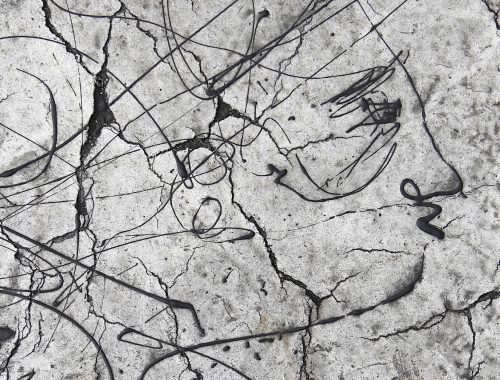
CARPE DIEM # 1 – noget om klatter
2023-01-28
Ophav
2024-07-19